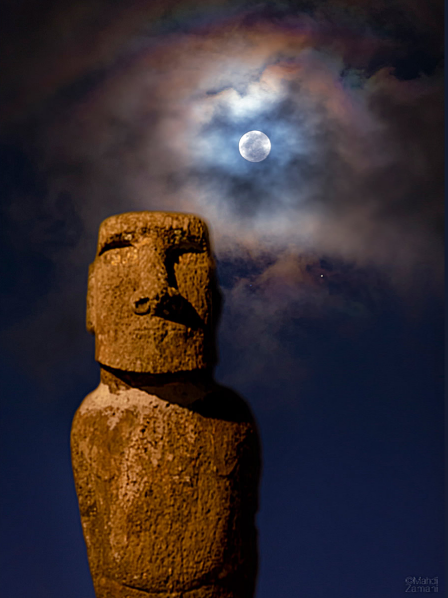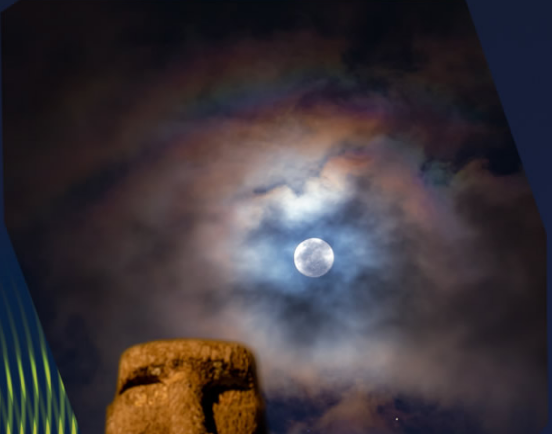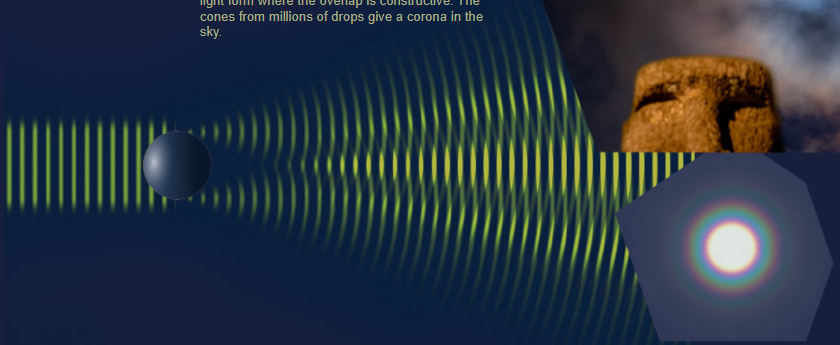Easter Island Moai & Corona
Easter Island Moai & Corona: Exploring the Phenomenon of Cloud Iridescence
The enigmatic Moai statues on Easter Island, also known as Rapa Nui, have witnessed a captivating atmospheric display - a cloud torn corona wrapping the Moon. This stunning scene, captured by Mahdi Zamani, showcases the ethereal beauty of the interaction between light and clouds.
The irregular shape of the corona adds an element of mystery to the spectacle. Parts of the corona dissolve into disordered cloud iridescence, creating a mesmerizing interplay of colors. It's fascinating to note that coronae and iridescence are essentially the same physical phenomenon, both resulting from the diffraction of light by tiny cloud droplets.
When parallel rays of moonlight reach a water droplet, they scatter from various points on its surface and leave as outgoing spherical waves. These waves overlap and interfere with each other, forming cones of bright light where the overlap is constructive. The collective effect of millions of water droplets gives rise to a corona in the sky.
A Mie calculation performed by IRIS, a tool used for simulating atmospheric phenomena, reveals the intricate structure of a corona. It shows a bright central aureole surrounded by rings of rapidly decreasing intensity. This calculation helps us understand the optical properties of coronae and provides insights into their formation.
The phenomenon of cloud iridescence is not limited to Easter Island or the Moai statues. It can occur in various atmospheric conditions and is often observed in high-altitude clouds, such as cirrus clouds. The delicate hues and patterns created by iridescence add a touch of magic to our skies, captivating observers worldwide.
Cloud iridescence occurs when sunlight or moonlight interacts with water droplets or ice crystals in the atmosphere. The diffraction and interference of light waves create the vibrant colors we see. The exact size and shape of the water droplets or ice crystals play a crucial role in determining the appearance of the iridescent display.
While cloud iridescence is a captivating sight, it is relatively rare compared to other atmospheric optical phenomena. Its occurrence depends on specific atmospheric conditions and the presence of the right types of clouds. Therefore, witnessing such a spectacle is truly a special and awe-inspiring experience.
The study of atmospheric optics allows us to unravel the mysteries behind these fascinating phenomena. Scientists and researchers employ various tools and techniques to simulate and analyze the behavior of light in the atmosphere. These investigations help deepen our understanding of the intricate interplay between light, particles, and atmospheric conditions.
In conclusion, the encounter between the Moai statues on Easter Island and the cloud torn corona provides a breathtaking glimpse into the world of atmospheric optics. The phenomenon of cloud iridescence, characterized by its vibrant colors and delicate patterns, continues to captivate observers worldwide. By delving deeper into the science behind these phenomena, we gain a greater appreciation for the wonders that unfold above us in the sky.

ΜΟΑΙ SATURN CORONA IRIDESCENCE
Mahdi Zamani (site, InstG) captured this scene a few hours before the lunar eclipse of July
�19.
On Easter Island, Rapa Nui, a Moai gazes impassively as a cloud torn corona wraps the Moon.
Image ©Mahdi Zamani, shown with permission

The corona is irregular. Distant parts dissolve into disordered cloud iridescence.
Coronae and iridescence are the same physical phenomenon. Tiny cloud droplets diffract moonlight.
Below: Parallel light rays from the left reach a water drop. They scatter from points all over its surface and leave as outgoing spherical waves. that's the diffraction bit.
The waves overlap and interfere. Cones of bright light form where the overlap is constructive. The cones from millions of drops give a corona in the sky.

A Mie calculation of a corona made by IRIS. There is a bright central aureole surrounded by rings of rapidly decreasing intensity.
Note: this article has been automatically converted from the old site and may not appear as intended. You can find the original article here.
Reference Atmospheric Optics
If you use any of the definitions, information, or data presented on Atmospheric Optics, please copy the link or reference below to properly credit us as the reference source. Thank you!
-
<a href="https://atoptics.co.uk/blog/easter-island-moai-corona/">Easter Island Moai & Corona </a>
-
"Easter Island Moai & Corona ". Atmospheric Optics. Accessed on April 20, 2024. https://atoptics.co.uk/blog/easter-island-moai-corona/.
-
"Easter Island Moai & Corona ". Atmospheric Optics, https://atoptics.co.uk/blog/easter-island-moai-corona/. Accessed 20 April, 2024
-
Easter Island Moai & Corona . Atmospheric Optics. Retrieved from https://atoptics.co.uk/blog/easter-island-moai-corona/.